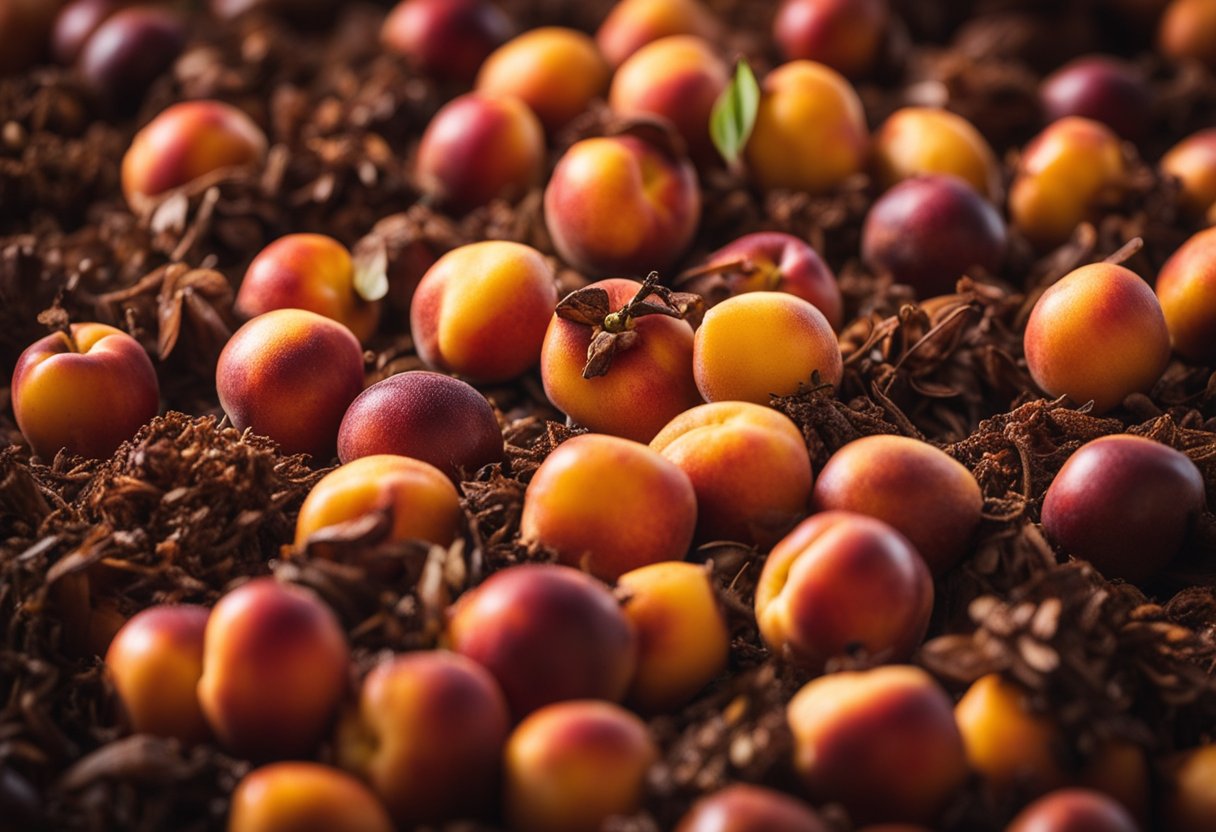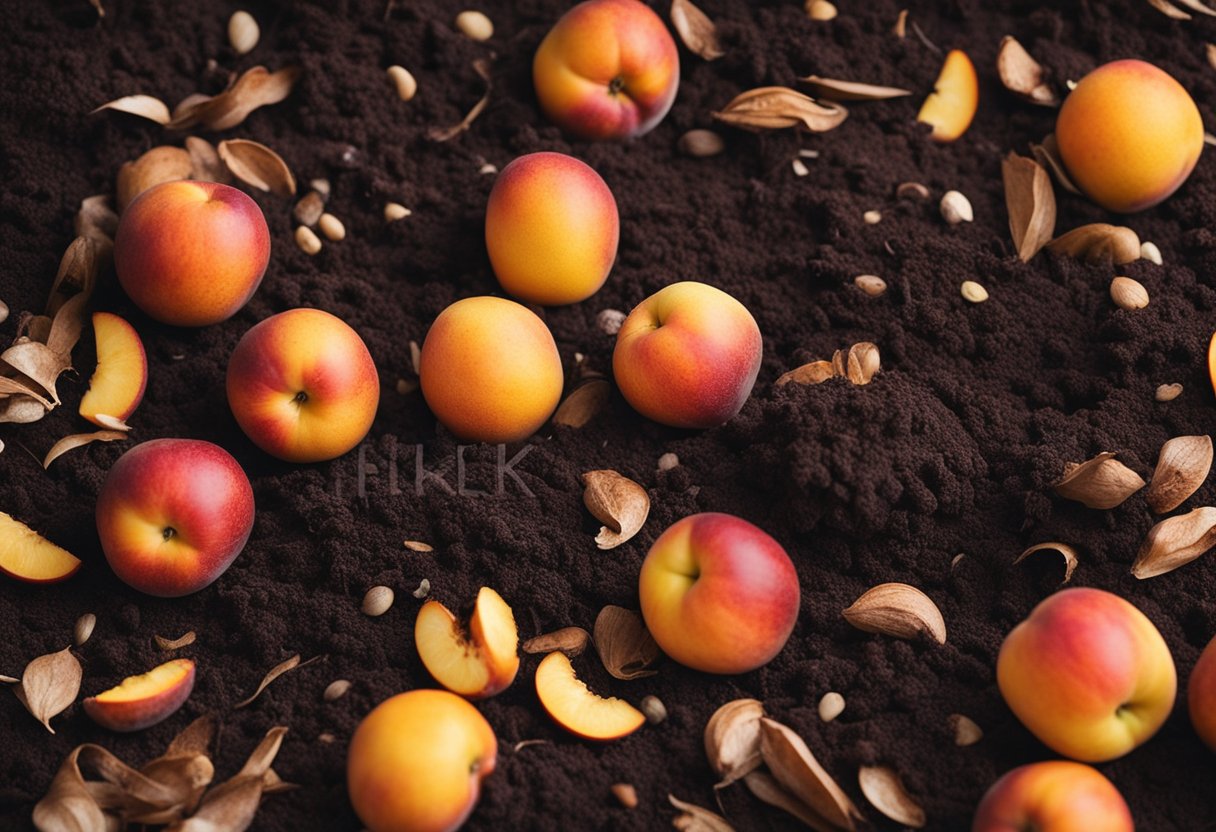As an Amazon Associate I earn from qualifying purchases.
At A Glance
Composting nectarine pits can be a bit challenging due to their hard and woody nature, which makes them slow to decompose. However, it is possible to compost them with a few extra steps. It’s advisable to break or crack the pits into smaller pieces to expedite the decomposition process, although doing so can be quite difficult and requires caution. You could also consider leaving the pits out in the weather for a while to help break them down naturally, or placing them in a high-heat composting system if available.
Composting is a great way to reduce waste and create nutrient-rich soil for your garden. However, not all organic materials are suitable for composting. When it comes to nectarine pits, the answer is not straightforward.

According to Confessions of a Composter, nectarine pits are hard and can take a long time to decompose. They can withstand the digestive system of animals and the sea, making them a tough material to break down in a compost bin. However, this doesn’t mean that you can’t compost nectarine pits at all. With the right conditions, it is possible to compost them successfully.
Most experts suggest that when including nectarine pits in your compost, it’s important to monitor the moisture levels closely. Nectarine pits are considered a wet material, so it’s recommended to balance them with dry brown ingredients like shredded paper and dried leaves. By doing so, you can create a balanced compost pile that will break down effectively and produce nutrient-rich soil for your garden.
Can You Compost Nectarine Pits?

As a composting enthusiast, I have often wondered whether nectarine pits can be composted. After some research, I have found that nectarine pits are indeed compostable, but they decompose very slowly due to their hard, woody shells.
Nectarine pits are made of lignin, a complex organic polymer that is resistant to decay. Therefore, it takes a long time for nectarine pits to break down in a compost pile. However, if you are patient, you can add nectarine pits to your compost pile and eventually, they will decompose.
It’s important to note that to speed up the decomposition process, you can smash the nectarine pits before adding them to your compost pile. This will help break down the hard outer shell and expose the inner flesh, which will decompose more quickly.
Additionally, it’s important to maintain the right temperature in your compost pile. The ideal temperature range for composting is between 135 and 160 degrees Fahrenheit. If the temperature is too low, the decomposition process will be slow, but if the temperature is too high, the organic matter in your compost pile will break down too quickly and you will lose valuable nutrients.
In summary, nectarine pits can be composted, but they decompose slowly due to their hard, woody shells. To speed up the decomposition process, smash the pits before adding them to your compost pile and maintain the right temperature range.
Preparation of Nectarine Pits for Composting
When it comes to composting nectarine pits, there are a few things to keep in mind to ensure that they break down properly and don’t cause any issues in your compost bin. The first step is to soak the seeds in water for a few days to help break down any remaining pulp. This will also help to remove any residual chemicals that may have been used in the growing process.
It’s important to note that nectarine pits, like many other fruit pits, have a period of dormancy that must be broken before they can germinate. This means that even if you compost the pits, they may not break down completely unless they have been properly prepared beforehand.
To prepare nectarine pits for composting, it’s best to first dry them out for a few days to break their dormancy. Once they have been dried, you can soak them in water for a few days to help break down any remaining pulp. After soaking, you can add the pits to your compost bin, making sure to bury them deep enough so that they are not exposed to the air.
It’s important to note that nectarine pits may take longer to break down than other compostable materials, so be patient and give them time to decompose fully. Additionally, make sure to turn your compost pile regularly to ensure that the materials are being properly aerated and broken down.
In summary, composting nectarine pits is possible, but it requires some preparation beforehand. Soak the seeds in water to remove any remaining pulp and break their dormancy, and make sure to bury them deep enough in your compost bin. With a little patience and attention, you can turn your nectarine pits into nutrient-rich compost for your garden.
Suitable Composting Materials

When it comes to composting, there are certain materials that are better suited for the process than others. Some materials will break down quickly and provide valuable nutrients for your soil, while others may take longer to break down or attract pests. Here are some materials that are suitable for composting:
Green Materials
Green materials are high in nitrogen and tend to be wetter types of ingredients. They include things like grass clippings, coffee grounds, flowers, and manure. These materials will help speed up the composting process and provide valuable nutrients for your soil.
Brown Materials
Brown materials are high in carbon and generally have a dry appearance. They include things like leaves, twigs, shredded cardboard, and shredded paper. These materials will help balance the moisture content of your compost and provide structure for the pile.
Eggshells
Eggshells are a great source of calcium for your soil and can be added to your compost pile. However, it’s important to crush them up before adding them to the pile to help them break down more quickly.
Newspaper
Newspaper can also be added to your compost pile, but it’s important to use only black and white newsprint with soy-based ink. Colored ink and glossy paper can contain harmful chemicals that are not suitable for composting.
Dry Leaves
Dry leaves are a great source of carbon for your compost pile and can be added in large quantities. However, it’s important to shred them before adding them to the pile to help them break down more quickly.
In general, most organic materials can be composted, but it’s important to avoid adding materials that can attract pests or contain harmful chemicals. By using a combination of green and brown materials, you can create a healthy compost pile that will provide valuable nutrients for your soil.
Materials to Avoid in Composting
As an avid composter, I have learned that not all materials are suitable for composting. While composting is a great way to reduce waste and create nutrient-rich soil, it is important to know what materials should be avoided to ensure the composting process is effective and safe.
One material that should be avoided is pesticides. Pesticides can harm the beneficial microorganisms that break down the organic matter in the compost pile. It is best to avoid using any plants that have been treated with pesticides in your compost pile.
Another material to avoid is meat and bones. Meat and bones can attract pests and create a foul smell in the compost pile. Additionally, these materials take a long time to decompose and can slow down the composting process.
Grease and oils should also be avoided in composting. These materials can create an anaerobic environment in the compost pile, which can lead to unpleasant odors and slow down the decomposition process.
Coal and charcoal should also be avoided in composting. These materials can contain harmful chemicals that can contaminate the soil and harm plants.
Diseased plants should not be added to compost piles as they can spread disease to other plants.
Cheese and other dairy products should also be avoided in composting. These materials can attract pests and create unpleasant odors in the compost pile.
Cat litter and pet waste should also be avoided in composting. These materials can contain harmful pathogens that can contaminate the soil and harm plants.
Corn cobs and dryer lint should also be avoided in composting. These materials take a long time to decompose and can slow down the composting process.
Finally, cooked food should be avoided in composting. Cooked food can attract pests and create unpleasant odors in the compost pile.
By avoiding these materials, you can ensure that your compost pile is effective and safe.
Composting Methods
When it comes to composting nectarine pits, it’s important to choose the right composting method. Some composting methods may not be able to break down the hard pits efficiently, which can lead to slower composting or even clogging of the compost bin.
One effective method for composting nectarine pits is to use a vermicomposting system. This system uses worms to break down organic matter, including fruit pits. The worms consume the pits and excrete nutrient-rich castings, which can be used as a fertilizer for plants. Vermicomposting is a great option for those who want to compost indoors or have limited outdoor space.
Another method for composting nectarine pits is to use a wire bin. Wire bins allow for good air circulation, which is essential for composting. Simply add the fruit pits to the bin along with other organic matter, such as leaves and grass clippings. Turn the pile every few weeks to ensure that the compost is evenly distributed.
If you have a backyard, you can also try home composting. This method involves creating a compost pile in your backyard and adding organic matter to it over time. You can use a variety of materials, such as food scraps, leaves, and grass clippings, to create a nutrient-rich compost. Be sure to chop up the nectarine pits before adding them to the pile to speed up the composting process.
Overall, there are several composting methods that can be used to compost nectarine pits. Whether you choose vermicomposting, a wire bin, or home composting, be sure to follow the proper guidelines for each method to ensure that your compost is healthy and nutrient-rich.
Composting Nectarine and Other Stone Fruits
As an avid composter, I have often wondered whether it’s okay to compost nectarine pits. After conducting some research, I have found that nectarine pits, along with other stone fruits like peaches, apricots, and plums, can be composted. However, they do not compost easily due to their hard exterior, so it’s important to take some precautions.
When composting stone fruits, it’s best to chop them up into small pieces before adding them to the compost bin. This will help them break down faster and more easily. Additionally, it’s important to balance the moisture level in the compost bin by adding dry brown ingredients like shredded paper or dried leaves.
Nectarine seeds can also be used to grow new nectarine trees. To do this, remove the pit from the fruit and soak it in water to remove any remaining pulp. If the pit floats, it’s not viable and you will need to try again with another pit. Air dry the seeds on the counter top for a day or two before planting them in a pot with soil.
In general, fruit trees like nectarine trees are a great addition to any garden. They not only provide delicious fruit, but they also help to improve the soil quality and biodiversity of the area. So, if you have the space and resources, consider planting a nectarine tree or other fruit tree in your yard.
Remember, composting nectarine pits and other stone fruits requires some extra effort, but it’s worth it in the end. By composting these materials, you are helping to reduce waste and create nutrient-rich soil for your garden.
